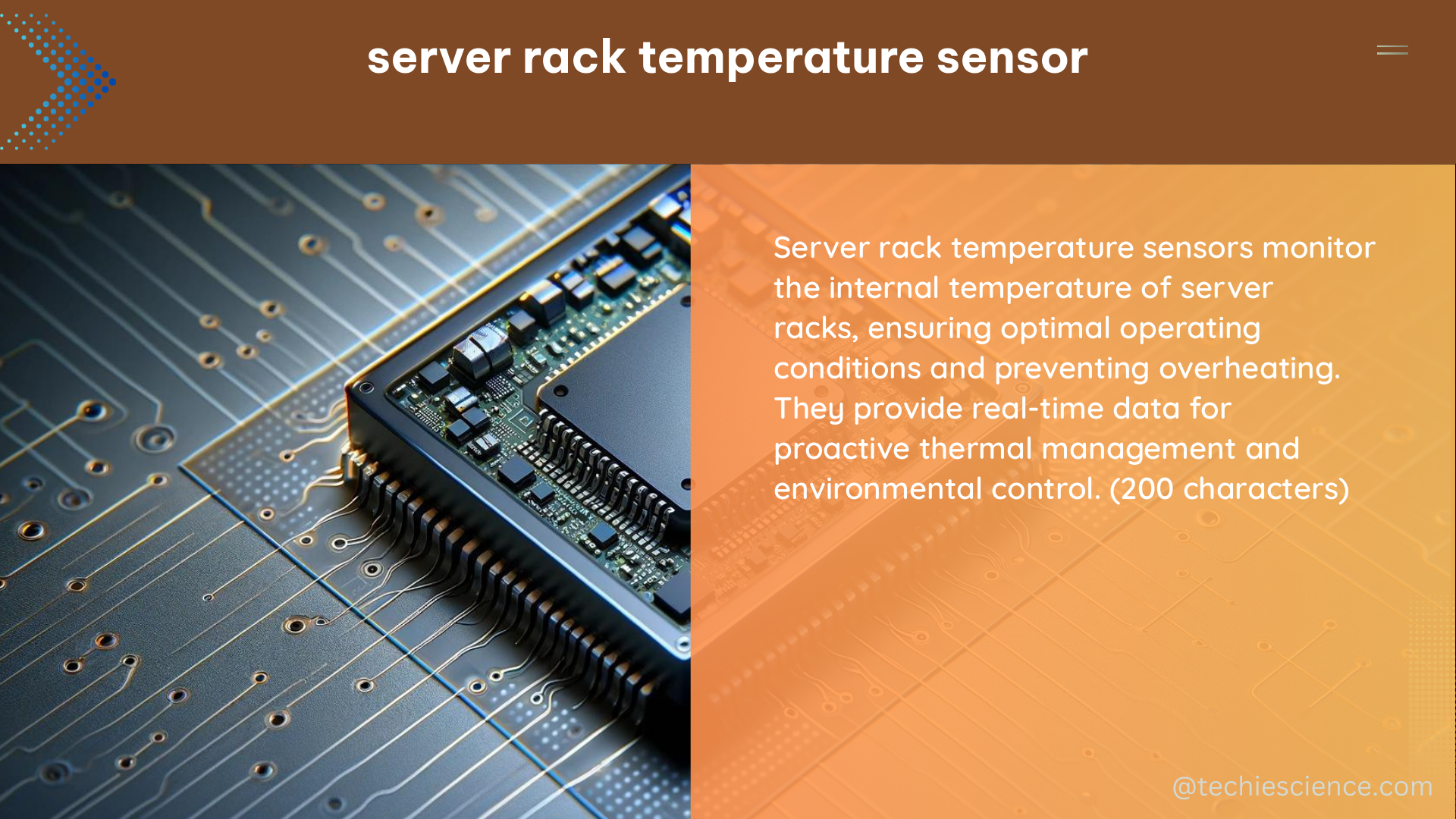Server rack temperature sensors are crucial for maintaining the optimal environmental conditions within a data center, ensuring the reliable performance and longevity of mission-critical equipment. These sensors play a vital role in monitoring the temperature and humidity levels, allowing for early detection of potential issues and enabling proactive measures to prevent equipment failure.
Understanding the Importance of Rack Temperature Monitoring
According to the ASHRAE (American Society of Heating, Refrigerating and Air-Conditioning Engineers) guidelines, the recommended inlet temperature range for data centers is 18°C to 27°C (64°F to 80°F), with the outlet temperature being no more than 20°C (35°F) higher than the inlet temperature. Maintaining these temperature thresholds is essential for the proper functioning and longevity of server equipment, as excessive heat can lead to hardware failures, data loss, and even fire hazards.
Proper placement of temperature sensors is crucial for accurate monitoring. In high-density data centers, it is recommended to have a minimum of 6 sensors per rack, strategically positioned at the top, bottom, middle, and back of the rack to monitor both inlet and outlet air temperatures. This comprehensive approach ensures that any hot spots or temperature fluctuations are quickly identified and addressed.
Wireless Temperature Sensors: Advantages and Considerations

Wireless temperature sensors have gained popularity in recent years due to their numerous advantages over traditional wired solutions. These sensors offer:
- Cost Savings: Wireless sensors eliminate the need for extensive cabling infrastructure, reducing installation and maintenance costs.
- Improved Accuracy: Wireless sensors can be placed closer to the critical equipment, providing more accurate temperature readings.
- Enhanced Accessibility: Wireless sensors allow for easy relocation and reconfiguration, enabling flexible monitoring solutions.
- Real-time Monitoring: Wireless sensors enable continuous, real-time temperature monitoring, allowing for immediate detection and response to any temperature anomalies.
When selecting wireless temperature sensors for your data center, consider factors such as battery life, transmission range, and compatibility with your existing monitoring systems. Ensure that the sensors meet the required accuracy and resolution specifications to provide reliable data for informed decision-making.
DIY Solutions: Raspberry Pi and Temperature Sensor Setups
For DIY enthusiasts and small-scale data centers, a Raspberry Pi-based temperature monitoring solution can be a cost-effective and customizable option. By pairing a Raspberry Pi with a compatible temperature sensor, such as the DS18B20 or the DHT11/DHT22, you can create a versatile monitoring system that can be tailored to your specific needs.
The advantages of a Raspberry Pi-based solution include:
- Affordability: A complete Raspberry Pi-based setup, including the board, temperature sensor, and necessary accessories, can be assembled for under $100.
- Customization: The open-source nature of Raspberry Pi allows for extensive customization, enabling you to create custom alerts, dashboards, and data visualization tools.
- Scalability: As your data center grows, you can easily expand the Raspberry Pi-based monitoring system by adding more sensors or deploying additional units.
- Remote Accessibility: By integrating the Raspberry Pi with cloud-based platforms or VPN access, you can remotely monitor and manage your data center’s temperature from anywhere.
When setting up a Raspberry Pi-based temperature monitoring system, consider factors such as sensor placement, data logging, and integration with your existing infrastructure or monitoring software.
Commercial Solutions: Comprehensive Monitoring Platforms
For organizations seeking a more comprehensive and enterprise-grade temperature monitoring solution, there are several commercial options available, such as:
- ITwarchdogs: This solution offers a small, cost-effective temperature probe that can be easily integrated into your data center’s monitoring system. The ITwarchdogs probe provides real-time temperature and humidity tracking, with customizable alerts and reporting capabilities.
- RoomAlert: RoomAlert is a popular environmental monitoring platform that offers a range of temperature, humidity, and other environmental sensors. The system provides remote monitoring, data logging, and advanced alerting features to ensure optimal data center conditions.
- TempStick: TempStick is a versatile temperature and humidity monitoring solution that can be deployed across multiple locations. It offers features like remote access, data trending, and integration with building management systems.
These commercial solutions often come with additional features, such as multi-site monitoring, cloud-based dashboards, and integration with existing infrastructure, making them suitable for larger or more complex data center environments.
Conclusion
Server rack temperature sensors are a critical component of any well-designed data center monitoring strategy. By maintaining optimal temperature and humidity levels, these sensors help ensure the reliable performance and longevity of mission-critical equipment, preventing costly downtime and equipment failures.
Whether you choose a DIY Raspberry Pi-based solution or a comprehensive commercial platform, the key is to implement a robust temperature monitoring system that provides real-time insights, customizable alerts, and the ability to proactively address any environmental issues within your data center.
By following the best practices and guidelines outlined in this comprehensive guide, you can ensure that your server rack temperature monitoring setup is tailored to your specific needs, delivering the insights and control necessary to maintain a healthy and efficient data center environment.
References:
- Thermal Guidelines and Temperature Measurements in Data Centers, LBL, 2020.
- Server Room Temperature Monitoring – Where to stick my probes?, ServerFault, 2013.
- Cheap server room temperature monitoring?, Reddit, 2021.
- Rack Temperature Monitoring in Data Center, AKCP, 2021.
- Types of Temperature Sensors For Data Centers, AKCP Monitoring, 2021.

The lambdageeks.com Core SME Team is a group of experienced subject matter experts from diverse scientific and technical fields including Physics, Chemistry, Technology,Electronics & Electrical Engineering, Automotive, Mechanical Engineering. Our team collaborates to create high-quality, well-researched articles on a wide range of science and technology topics for the lambdageeks.com website.
All Our Senior SME are having more than 7 Years of experience in the respective fields . They are either Working Industry Professionals or assocaited With different Universities. Refer Our Authors Page to get to know About our Core SMEs.